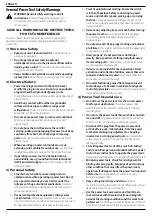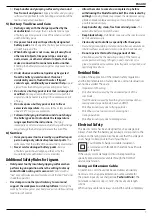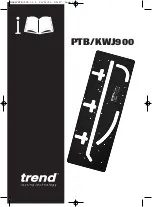
12
EngliSh
ASSEMBLY AND ADJUSTMENTS
WARNING: To reduce the risk of serious personal
injury, depress the trigger lock button and
disconnect battery pack before making any
adjustments or removing/installing attachments or
accessories.
An accidental start-up can cause injury.
WARNING:
Use only
D
e
WALT
battery packs and chargers.
Inserting and Removing the Battery Pack
from the Tool (Fig. C)
DCS335:
Move the on/off switch
1
to the OFF position before
inserting the battery pack.
nOTE:
Make sure your battery pack
11
is fully charged.
To Install the Battery Pack into the Tool
Handle
1. Align the battery pack
11
with the rails inside the
tool’s handle.
2. Slide it into the handle until the battery pack is firmly seated
in the tool and ensure that you hear the lock snap into place.
To Remove the Battery Pack from the Tool
DCS335:
Move the on/off switch
1
to the OFF position before
removing the battery pack.
1. Press the release button
12
and firmly pull the battery pack
out of the tool handle.
2. Insert battery pack into the charger as described in the
charger section of this manual.
Fuel Gauge Battery Packs (Fig. C)
Some
D
e
WALT
battery packs include a fuel gauge which
consists of three green LED lights that indicate the level of
charge remaining in the battery pack.
To actuate the fuel gauge, press and hold the fuel gauge button.
A combination of the three green LED lights will illuminate
designating the level of charge left. When the level of charge
in the battery is below the usable limit, the fuel gauge will not
illuminate and the battery will need to be recharged.
nOTE:
The fuel gauge is only an indication of the charge left on
the battery pack. It does not indicate tool functionality and is
subject to variation based on product components, temperature
and end-user application.
Blade Installation and Removal (Fig. D, J)
To Install a Blade
nOTE:
This jig saw uses only T-shank jig saw blades.
nOTE:
The DT2074 flush cutting blade is for use with
D
e
WALT
DCS334 and DCS335 jig saws only.
nOTE:
When installing flush cutting blades (DT2074), the anti-
splinter insert (
20
, Fig. J) must be removed and the shoe must
to be in the 0° positive stop position.
nOTE:
The correct saw blade must be selected for the material
being cut.
1. Hold open the blade release latch
4
as shown in Figure D.
2. Insert the T-shank blade into the clamp mechanism
13
while guiding the back of the blade into the groove of the
guide rollers
14
.
3. The T-shank should be completely inside the
clamp mechanism.
4. Release the blade release latch.
To Remove a Blade
CAUTION:
Do not touch used blades, they may be hot.
Personal injury may result.
1. Hold open the blade release latch
4
.
2. With a slight shake the blade will drop out.
3. Release the blade release latch.
Beveling the Shoe (Fig. E)
To Bevel the Shoe
1. Remove the dust extraction accessories if they are mounted
to the tool as the tool will not bevel if they are attached.
Refer to
Dust Extraction
section.
2. Unlock the shoe by pulling the shoe bevel lever
8
to
the side.
3. Slide the shoe
7
forward to release it from the 0° positive
stop position.
nOTE:
The shoe can be beveled to the left or to the right
at a maximum of 45° in either direction. There are visible
detents at 15° and 30°.
4. Once the desired bevel angle is achieved, lock the shoe in
position:
a. For 0° and 45° bevel angles, slide the shoe back and lock
the shoe by moving the bevel lever back under the body
of the jig saw.
b. For all angles between 0° and 45°, lock with bevel
lever only.
Cutting Action—Orbital or Straight (Fig. F)
This jig saw is equipped with four cutting actions, three orbital
and one straight. Orbital action has a more aggressive blade
motion and is designed for cutting in soft materials like wood
or plastic. Orbital action provides a faster cut, but with a less
smooth cut across the material. In orbital action, the blade
moves forward during the cutting stroke in addition to the up
and down motion.
nOTE:
Metal or hardwoods should never be cut in orbital action.
To adjust the cutting action,
move the orbital action lever
6
between the four cutting positions: 0, 1, 2, and 3. Position 0 is
straight cutting. Positions 1, 2, and 3 are orbital cutting. The
aggressiveness of the cut increase as the lever is adjusted from
one to three, with three being the most aggressive cut.
Summary of Contents for XR DCS334
Page 1: ...DCS334 DCS335 ...
Page 2: ...B Copyright DeWALT English 5 한국어 16 ...
Page 3: ...1 Fig A 그림 A DCS334 4 5 6 8 7 1 2 3 9 DCS335 5 6 7 1 9 3 8 10 4 10 ...
Page 4: ...2 Fig B 그림 B Fig C 그림 C Fig D 그림 D Fig E 그림 E 12 12 11 11 14 13 4 8 7 ...
Page 6: ...4 Fig L 그림 L Fig M 그림 M 9 DCS334 DCS335 9 Fig N 그림 N ...
Page 28: ...N696976 05 2019 ...













































